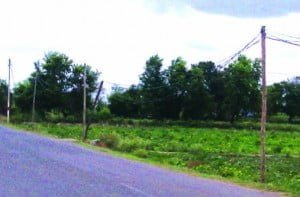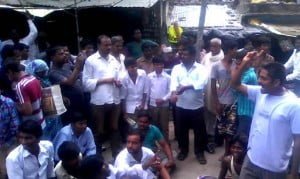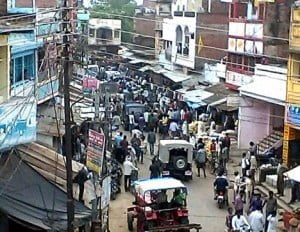Ever since the Samajwadi Party government came to power in 2012, Chief Minister Akhilesh Singh Yadav has made tall claims of improving rural electrification in Uttar Pradesh. On 22 August, laying the foundation of a power sub station in old Lucknow, he said that his government would provide 24 hours power supply in cities, 22 hours in district headquarters and 16 hours in rural parts of the state by next year. But in Bundelkhand, districts continue to face severe electricity shortage and infrastructural problems. In Chitrakoot district, several areas reported daily power supply of merely 3-4 hours this month. Moreover, at least 6 deaths caused by high tension wires electrocuting people have been reported from the district in the last 2 months alone.
‘There are electricity poles, the wiring has been done. We even have metres in the houses and get bills but what’s the point if power supply lasts only 4 hours during the day?’ asked a frustrated resident of Mau, a busy kasba in the district’s Mau block. Earlier this month on 8 August, more than 50 residents of Mau had protested against power cuts outside the local Power House but no attention has been paid to their demands or to the deteriorating situation. The protest was brought to an end by the Tehsildar Gulab Singh, who ‘promised to look into the matter.’ The severe power outages may sound familiar and a common feature in rural India but these outages are becoming threats to microeconomies in these parts. ‘Our businesses are suffering,’ said Khunnu, the owner of a flour factory in the main market. ‘If there is no electricity for a major part of the day, how are we to work the chakki (grain grinder) to make flour? We cannot be expected to afford fuel-run generators everyday.’
Power outages have also intensified the water crisis that has plagued the Bundelkhand area year after year. ‘Tubewells don’t work. Drought stricken farmers are forced to spend on artificial irrigation at a time when they are still trying to overcome the last crop cycle’s loss,’ said Ram Murat, a poor farmer from a village in Mau block. ‘The cost of irrigating 1 bigha of land for an hour is almost 500 rupees. How are we to afford it?’ When asked, the Junior Engineer for Mau shrugged the question off. ‘What am I supposed to say? The government when power will be cut and in what area,’ he said.
 Rural electrification in Uttar Pradesh is besieged by multiple problems: including not only power shortages but also shockingly poor and dangerous infrastructure. A few months ago Khabar Lahariya had reported how a village in Faizabad district was running on power supply flowing through bamboo poles. This, when in the annual budget this year, the Chief Minister allocated over 25,000 crores for maintenance work in the energy sector. In many villages in UP, live wires dangle precariously from old dilapidated poles. Elsewhere, poles have been installed but there are no wires. In Chitrakoot district’s Pahadi block, a number of villages have been rocked by recent deaths all of which were caused by high tension live wires falling on unsuspecting people and electrocuting them to death.
Rural electrification in Uttar Pradesh is besieged by multiple problems: including not only power shortages but also shockingly poor and dangerous infrastructure. A few months ago Khabar Lahariya had reported how a village in Faizabad district was running on power supply flowing through bamboo poles. This, when in the annual budget this year, the Chief Minister allocated over 25,000 crores for maintenance work in the energy sector. In many villages in UP, live wires dangle precariously from old dilapidated poles. Elsewhere, poles have been installed but there are no wires. In Chitrakoot district’s Pahadi block, a number of villages have been rocked by recent deaths all of which were caused by high tension live wires falling on unsuspecting people and electrocuting them to death.
In the same block, last year a Class 3 student was electrocuted to death when he went to a nearby field to relieve himself. At the time of the incident, the District Education Officer Mr. V.K. Singh had blamed the Electricity Department of having left several wires hanging dangerously. No action was taken in the case. On the night of 10 August, in Khopa village of the block, an 11,000-volt wire fell and 3 members of the same family were electrocuted to death. Residents of this village have been complaining of the state of these wires for the last 6 years but non of the thousands of crores sanctioned for maintenance work seem to have made it to this village. On 11 August, Phoola from Pahadi’s Kaarmchaari village was feeding her animals when a live wire fell on the stable. Phoola is recuperating from injuries but 2 of her cows died. ‘The loss is huge. Each calf cost 3,000 rupees. It’ll take a while for the family to overcome the loss, not to mention living with the constant fear that an accident like this might recur,’ said Phoola.
 Manikpur block in Chitrakoot, remote, forested, hilly and with a large tribal population too is facing a major power crisis. On 20 July, Sushil Kumar of Khatwara village died when a live wire fell on him. People from 62 villages gathered to stage a massive protest against the issue on 9 August. Markets remain closed and shopkeepers, incensed due to power outages lasting as long as 2 days, stopped the Sub Divisional Magistrate’s car to apprise him of their predicament. ‘In Khatwara village, wires are hanging as low as 6 feet. Even though a man died, no urgency was shown on the part of the local administration,’ said Kamlesh, an angry protester.
Manikpur block in Chitrakoot, remote, forested, hilly and with a large tribal population too is facing a major power crisis. On 20 July, Sushil Kumar of Khatwara village died when a live wire fell on him. People from 62 villages gathered to stage a massive protest against the issue on 9 August. Markets remain closed and shopkeepers, incensed due to power outages lasting as long as 2 days, stopped the Sub Divisional Magistrate’s car to apprise him of their predicament. ‘In Khatwara village, wires are hanging as low as 6 feet. Even though a man died, no urgency was shown on the part of the local administration,’ said Kamlesh, an angry protester.
Amidst the chaos and anger across the district, the Executive Engineer of the Electricity Department in Chitrakoot, Rajmani Vishwakarma coolly said, ‘All rural areas in the district are being supplied with 15 hours of electricity.’ His answer, as far from ground reality as it might be, is close enough to the promises Akhilesh Yadav’s government has been making – 16 hours of electricity in rural India and upto 22 hours of electricity supply at the district level by 2016 – a promise that is sounding more and more hollow every day.
Click here to read original Hindi story
